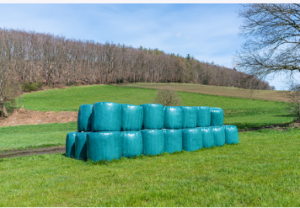silage wrap is a product that protects your bales from the elements. It is a form of plastic to wrap bales in before silaging them. The benefits of using this product are numerous.
 Moisture control
Moisture control
Delayed wrapping to control moisture can be a potential solution for alfalfa silage. However, delaying bale wrapping may delay fermentation, reducing silage quality.
Several studies have investigated the effects of delayed wrapping on silage fermentation. In particular, delays beyond 24 h result in reduced production of fermentation acids. However, little is known about the effect of wrap delay on the nutrient value of baled alfalfa silage. The present study tested the impact of delayed wrapping on DM and foraged nutritional quality of baled annual ryegrass silage.
A field experiment was conducted in May-August 2016 at the University of Arkansas Southwest Research & Extension Center near Perrytown, AR. The area in the field was randomly assigned to either the moisture level or wrapping delay treatments.
Silages were cured for 72 h before baling. Core samples were composited from both sides of the bale. After baling, bales were placed in plastic freezer bags and stored in an ultralow freezer. They were then suspended and respired for further analysis.
Wet bale weights declined linearly with time delay, and methanol concentrations increased in response to the wrapping delay. Butyric acid concentrations were also elevated.
The clostridial activity was detected on some bales. Residual WSC concentrations after silage fermentation were higher in the bales wrapped on d 0. These results indicate clostridial activity during silage fermentation. It is important to note that these levels of WSC were more significant than the 0-d positive control.
The wrapping delay did not impact pH, lactic acid, acetic acid, or butyric acid concentrations. However, acetic acid concentrations were higher in bales wrapped on d 0 than in bales wrapped after a time delay. Similarly, butyric acid concentrations were higher in bales covered on d 0 than in bales wrapped after a time delay.
The final pH of bales wrapped on d 0 was the most acidic. Finally, wet bale weights decreased with linearly increasing wrapping delay. Although wrapping delay had no significant effects on silage nutrient quality, delayed wrapping did affect the rate and final pH of fermentation.
Oxygen barrier
The oxygen barrier in silage wrap is essential in reducing feed spoilage. It prevents bacterial and fungal growth and can also help maintain the feed’s nutritional value.
Oxygen leakage into a bale can cause loss of spoilage and dry matter (DM). It has a significant economic impact on a farmer, especially since 5% of the nutritional value of the feed is lost due to oxygen leakage.
In recent years, multi-layer silage film technologies have emerged. These may include two outer layers of polyethylene and a core layer of an oxygen barrier material.
One type of oxygen barrier in silage wrap is made from EVOH, a chemical wall used in agricultural films. It provides excellent barrier properties in flexible applications but is easily cracked by repeated flexing.
Another type of OB film is Silostop, manufactured by B. Rimini Ltd, and the film is an 80-um layer product that acts as a two-in-one cling film. Silostop is a strong, light, and durable solution for large-scale applications.
In addition, a particular EVOH grade improves the hygienic quality of baled silages. However, a specific oxygen barrier film is relatively costly and can be challenging to recycle.
The present invention overcomes these issues in the prior art. It provides a multi-layer film for silage with improved mechanical properties. Moreover, it can be produced on a 3-layer extruder.
Compared with standard PE, the oxygen permeability of the Oxygen Barrier in Silage Wrap was twenty-fold lower. This results in an anaerobic environment for the baled hay. Also, the pH of the bales was lower in OB than in PE.
The DM losses were also reduced when the OB film was used. Specifically, the losses were 7.68% for the standard PE film versus 4.56% for the OB film.
These results indicate that using a unique oxygen barrier film can reduce DM losses in silage. Therefore, especially in warmer weather, it can be very beneficial. Besides, it has the potential to improve the health of animals.
The advantages of this type of film are cost-effectiveness, flexibility, and the protection of the nutritional value of the feed. It is also made of environmentally friendly materials.
Durability
Silage wrap, or silage bale wrap, is a protective barrier that keeps insects, weeds, and diseases out of the crop. These covers can be made from either plastic or natural materials such as silage. A good silage wrap will have strong, flexible, and waterproof properties.
A good silage wrap can help protect a bale from damaging factors like UV radiation. The right type of wrap can prevent the loss of valuable nutrients in feed. It will also reduce the chance of mould forming on the bales.
A silage wrap is made from various layers, varying in thickness. Each layer has its unique properties. In general, a thicker weave provides more outstanding durability. It is especially helpful if the bale is exposed to long periods of direct sunlight.
A good silage wrap should also have a few other features. For instance, a transparent film will last longer than its opaque counterpart. Similarly, it should contain a UV stabilizer. Also, it should be impermeable to water vapour.
Several other features of a good silage wrap include high strength, flexibility, tack, and puncture resistance. However, the suitable wrap can also be expensive. So, depending on your needs, consider other options.
Some films offer a full 12-month guarantee against breakage. It is a great feature to have. If you do find that your wrap is damaged, you can repair it with silage film tape. You can also find UV-resistant silage film tape from specialist dealers.